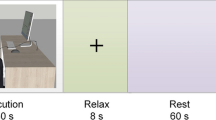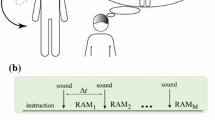Electroencephalogram (EEG) and electromyogram (EMG) traces were made in ten adult subjects in the resting state (eyes open) and on execution of real and imaginary rhythmically repeating movements. Vector autoregression modeling was used to evaluate the directed transfer function (DTF) for six bilaterally symmetrical EEG channels (F1/2, C3/4, and P5/6) and two EMG channels (flexor carpi radialis in the left and right upper limbs). Subjects executed real and imaginary repetitive opening and clenching of the right and left hands. Statistical analysis of DTF averaged in the α and γ ranges, corresponding to top-down and bottom-up corticomuscular influences, showed (1) top-down influences changed in different ways in the α and γ frequency ranges on transition from resting to imaginary and real movements. In the α range, these influences increased on performance of real movements while in imaginary movements they were no different from the resting state. In the γ range, the top-down influence of signals from the left frontal lead on the EMG channel of the right arm increased as compared with the resting state on performance of both real and imaginary movements; (2) that bottom-up influences showed a tendency to change: in real movements, these influences in both frequency ranges were slightly greater than at rest; (3) that bottom-up influences in both the α and γ ranges on imaginary movements displayed a tendency to take up a lower level than in controls; (4) that top-down influences in both frequency ranges were significantly greater than bottom-up influences; (5) that the greatest top-down influences in the α range in both real and imaginary movements were seen in the frontal rather than the central areas.
Similar content being viewed by others
References
Baccala, L. A. and Sameshima, K., “Partial directed coherence: a new concept in neural structure determination,” Biol. Cybern., 84, 463–474 (2001).
Baccala, L. A., Sameshima, K., Ballester, G., et al., “Studying the interaction between brain structures via directed coherence and Granger causality,” Applied Sig. Process., 5, 40–48 (1998).
Batula, A. M., Mark, J. A., Kim, Y. E., and Ayaz, H., “Comparison of brain activation during motor imagery and motor movement using fNIRS,” Computat. Intell. Neurosci., 2017, 5491296 (2017).
Budini, F., McManus, L. M., Berchicci, M., et al., “Alpha band cortico-muscular coherence occurs in healthy individuals during mechanically-induced tremor,” PloS ONE, 9, No. 12, e115012 (2004).
Côté, S. L., Hamadjida, X. A., Quessy, X. S., and Dancause, X. N., “contrasting modulatory effects from the dorsal and ventral premotor cortex on primary motor cortex outputs,” J. Neurosci., 37, No. 24, 5960–5973 (2017).
De Luca, C. J., “The use of surface electromyography in biomechanics,” J. Appl. Biomechanics, 13, 135–163 (1997).
Demougeot, L., Normand, H., Denise, P., and Papaxanthis, C., “Discrete and effortful imagined movements do not specifically activate the autonomic nervous system,” PLoS One, 4, No. 8, e6769 (2009), https://doi.org/10.1371/journal.pone.0006769.
Desmurget, M. and Sirigu, A., “A parietal-premotor network for movement intention and motor awareness,” Trends Cogn. Sci., 13, No. 10, 411–419 (2009).
Desmurget, M., Reilly, K. T., Richard, N., et al., “Movement intention after parietal cortex stimulation in humans,” Science, 324, 811–813 (2009).
Di Rienzo, F., Collet, C., Hoyek, N., and Guillot, A., “Impact of neurologic deficits on motor imagery: a systematic review of clinical evaluations,” Neuropsychol. Rev., 24, No. 2, 116–147 (2014).
Dum, R. P. and Strick, P. L., “Frontal lobe inputs to the digit representations of the motor areas on the lateral surface of the hemisphere,” J. Neurosci., 25, No. 6, 1375–1386 (2005).
Dum, R. P. and Strick, P. L., “The origin of corticospinal projections from the premotor areas in the frontal lobe,” J. Neurosci., 77, No. 3, 667–669 (1991).
Farina, D., Merletti, R., and Enoka, R. M., “The extraction of neural strategies from the surface,” J. Appl. Physiol., 96, 1486–1495 (2004).
Friston, K. J., “Functional and effective connectivity: A review,” Brain Connectivity, 1, No. 1, 13–36 (2011).
Frolov, A. A., Aziatskaya, G. A., Bobrov, P. D., et al., “Electrophysiological activity of the brain in controlling a brain–computer interface based on motor imagery,” Fiziol. Cheloveka, 43, No. 5, 17–28 (2017).
Graimann, B., Allison, B., and Pfurtcheller, G., “Brain–computer interfaces: a gentle introduction,” in: Brain–Computer Interfaces, The Frontiers Collection, Springer, Berlin Heidelberg (2009), pp. 1–27.
Graziano, M. S. A., Taylor, C. S. R., Moore, T., and Cooke, D. F., “The cortical control of movement revisited,” Neuron, 36, 349–362 (2002).
Gross, J., Tass, P. A., Salenius, S., et al., “Cortico-muscular synchronization during isometric muscle contraction in humans as revealed by magnetoencephalography,” J. Physiol., 527, No. 3, 623–631 (2000).
Grosse, P., Cassidy, M. J., and Brown, P., “EEG-EMG, MEG-EMG and EMG-EMG frequency analysis: physiological principles and clinical applications,” Clin. Neurophysiol., 113, 1523–1531 (2002).
Guillot, A. and Collet, C., “Contribution from neurophysiological and psychological methods to the study of motor imagery,” Brain Res. Brain Res. Rev., 50, 387–397 (2005).
Halliday, D. M., Conway, B. A., Farmer, S. F., and Rosenberg, J. R., “Using electroencephalography to study functional coupling between cortical activity and electromyograms during voluntary contractions in humans,” Neurosci. Lett., 241, 5–8 (1998).
Ives-Deliperi, V. L. and Butler, J. T., “Relationship between EEG electrode and functional cortex in the international 10 to 20 system,” J. Clin. Neurophysiol., 35, No. 6, 504–509 (2018).
Jeannerod, M., “Mental imagery in the motor context,” Neuropsychologia, 33, No. 11, 1419–1432 (1995).
Jeannerod, M., “Neural simulation of action: A unifying mechanism for motor cognition,” NeuroImage, 14, S103–S109 (2001).
Kamiński, M., Ding, M., Truccolo, W. A., and Bressler, S. L., “Evaluating causal relations in neural systems: Granger causality, directed transfer function and statistical assessment of significance,” Biol. Cybern., 85, 145–157 (2001).
Kilner, J. M., Baker, S. N., Salenius, S., et al., “Human cortical muscle coherence is directly related to specific motor parameters,” J. Neurosci., 20, No. 23, 8838–8845 (2000).
Kilner, J. M., Baker, S. N., Salenius, S., et al., “Task-dependent modulation of 1530 Hz coherence between rectified EMGs from human hand and forearm muscles,” J. Physiol., 516, No. 2, 559–570 (1999).
Kurganskii, A. V., “Some questions of studies of corticocortical functional connections using a vector autoregression model of the multichannel EEG,” Zh. Vyssh. Nerv. Deyat., 60, No. 5, 630–649 (2010).
Li, S., Kamper, D. G., Stevens, J. A., and Rymer, W. Z., “The effect of motor imagery on spinal segmental excitability,” J. Neurosci., 27, 9674–9680 (2004).
Likhachev, S. A., Vashchilin, V. V., and Dik, S. K., “Tremor: phenomenology and recording methods,” Meditsinsk. Zh., No. 2, 133–137 (2010).
Mokienko, O. A., Chernikova, L. A., Frolov, A. A., and Bobrov, P. D., “Motor imagery and its practical application,” Zh. Vyssh. Nerv. Deyat., 63, No. 2, 195–204 (2013).
Omlor, W., Patino, L., Hepp-Reymond, M. C., and Kristeva, R., “Gammarange corticomuscular coherence during dynamic force output,” NeuroImage, 34, 1191–1198 (2007).
Pfurtcheller, G., Brunner, C., Schlogl, A., and Lopes da Silva, F. H., “Mu rhythm (de)synchronization and EEG single-trial classification of different motor imagery tasks,” Neuroimage, 31, 153–159 (2006).
Reyes, A., Laine, C. M., Kutch, J. J., and Valero-Cuevas, F. J., “Beta band corticomuscular drive reflects muscle coordination strategies,” Front. Comput. Neurosci., 11, 17 (2017).
Sheahan, H. R., Ingram, J. N., Žalalytė, G. M., and Wolpert, D. M., “Imagery of movements immediately following performance allows learning of motor skills that interfere,” Sci. Rep., 8, 14330 (2018).
Stolbkov, Yu. K., Moshonkina, T. R., Orlov, I. V., et al., “Motor imagery as a means of improving the rehabilitation of motor functions,” Usp. Fiziol. Nauk., 49, No. 2, 45–59 (2018).
Verstynen, T., Jarbo, K., Pathak, S., and Schneider, W., “In vivo mapping of microstructural somatotopies in the human corticospinal pathways,” J. Neurophysiol., 105, 336–346 (2011).
Yang, Y., Dewald, J. P. A., van der Helm, F. C. T., and Schouten, A. C., “Unveiling neural coupling within the sensorimotor system: directionality and nonlinearity,” Eur. J. Neurosci., 48, 2407–2415 (2018).
Author information
Authors and Affiliations
Corresponding author
Additional information
Deceased (A. A. Frolov).
Translated from Zhurnal Vysshei Nervnoi Deyatel’nosti imeni I. P. Pavlova, Vol. 70, No. 6, pp. 738–751, November–December, 2020.
Rights and permissions
About this article
Cite this article
Kurgansky, M.E., Bobrov, P.D., Frolov, A.A. et al. Corticomuscular Interactions in Real and Imaginary Arm Movements. Neurosci Behav Physi 51, 724–733 (2021). https://doi.org/10.1007/s11055-021-01128-9
Received:
Revised:
Accepted:
Published:
Issue Date:
DOI: https://doi.org/10.1007/s11055-021-01128-9




